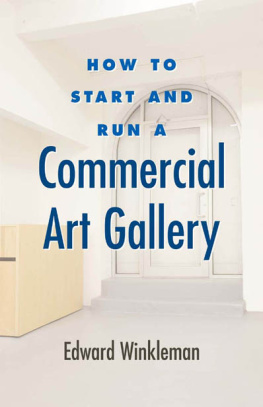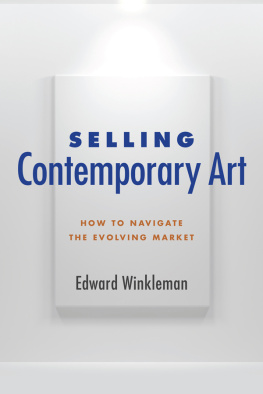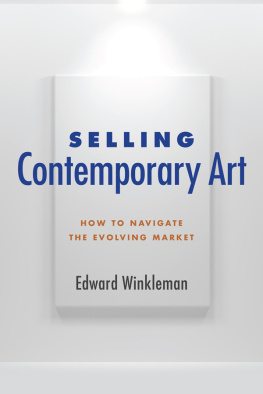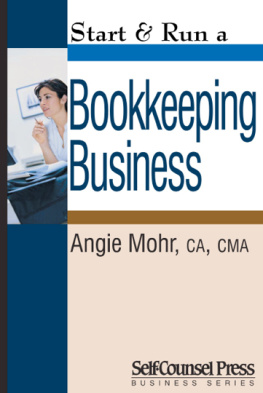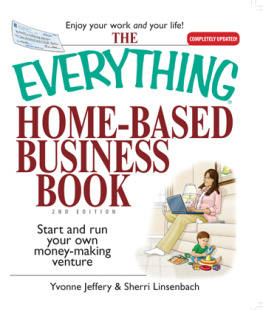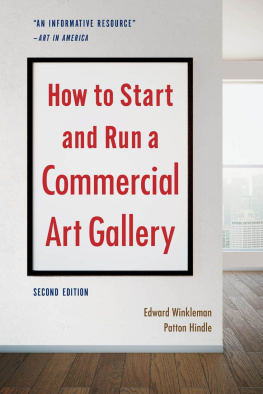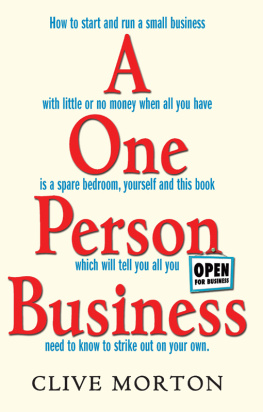HOW TO
START AND
RUN A
Commercial
Art Gallery

Edward Winkleman

2009 Edward Winkleman
All rights reserved. Copyright under Berne Copyright Convention, Universal Copyright Convention, and Pan-American Copyright Convention. No part of this book may be reproduced, stored in a retrieval system, or transmitted in any form, or by any means, electronic, mechanical, photocopying, recording, or otherwise, without prior permission of the publisher.
12 11 10 09 08 5 4 3 2 1
Published by Allworth Press
An imprint of Allworth Communications, Inc.
10 East 23rd Street, New York, NY 10010
Cover design by Mary Belibasakis
Interior design by Mary Belibasakis
Page composition/typography by Integra Software Services, Pvt., Ltd., Pondicherry, India
Cover photo by Mike Garten
ISBN-13: 978-1-58115-664-5
ISBN-10: 1-58115-664-2
eBook ISBN: 978-1-58115-722-7
Library of Congress Cataloging-in-Publication Data:
Winkleman, Edward.
How to start and run a commercial art gallery / Edward Winkleman.
p. cm.
Includes bibliographical references.
ISBN 978-1-58115-664-5
1. Art galleries, CommercialManagement. 2. New business enterprisesManagement. I. Title.
N8620.W56 2009
708.0068dc22
2009011839
Printed in the United States of America
TABLE OF CONTENTS
To Murat (Bambino) Orozobekov
INTRODUCTION

The Easy Part and the Hard Part
S hortly after moving to New York City, I met a producer of off-Broadway plays at a party. Listening to him describe his passion, I grew highly impressed with his resilience in finding backers for his productions. He said he wouldnt even begin to become discouraged until the thirteenth potential investor turned him down. In fact, he took anything other than a flat-out No! as encouragement, and he rarely accepted the first No! as a final answer, anyway. Nothing was going to dissuade him from following his dream.
I was busy soaking up these insights, so I was caught by surprise when he asked what I was doing in New York. What was my dream, he wanted to know.
Id like to open an art gallery, I answered.
Thats great, he replied. How are you going about doing that?
Er... uh... well, I said. Im doing studio visits with lots of artists, and working freelance for a gallery, and attending art fairs, and...
Thats the lamest thing Ive ever heard, he interjected.
Excuse me? I asked, visibly offended.
What is an art gallery? he continued. Its a space with art on the walls. If you want to open an art gallery, get a space and put art on the walls.
Wait... er... its not that simple, I protested.
Yes, it is, he insisted. Its exactly that simple. Get a space, put art on the walls, and you will have an art gallery.
He was right, of course. It was that simple. Six months after that conversation, I rented a space on the Lower East Side for a weekend, put art on the walls, and had my first (if highly temporary) art gallery. I even sold some work. What the producermentor didnt tell me back then, though, was that finding a space and putting art on the walls is the easy part. Staying in business is the real trick.
As with many small businesses, new art galleries have a fairly high attrition rate. There are several specific reasons for this in the commercial art business. First, it can take at least three years before a new gallery will become profitable, perhaps more if the artists in the program are emerging. Second, the paths most art dealers take to opening their own spaces do not include much in the way of classic business administration. Third, you wont go very far in the art business without a real passion for art; if you dont have one, you should probably reconsider opening a gallery. Finally, to be successful, you will need more than passion or even business experience; youll need entrepreneurial instincts. With all that in mind, the focus in this book is on the business side of starting and running a commercial art gallery, with an emphasis on which standard practices are perhaps ripe for entrepreneurial innovation.
Indeed, because an art gallery is such an individual enterprise, standard practices are constantly evolving as new players with new agendas enter the field. From deciding on the percentage of sales that goes to artists in consignment agreements, to establishing resale rights for living artists and their estates, to figuring out how many artists a gallery can effectively represent, long-standing guidelines are continuously being rewritten by newcomers. Even the term that gallery owners use to refer to themselves keeps evolving. Early in the twentieth century, the phrase picture seller was quite common, and lingers on, especially in the secondary market, although it carries the connotation of antiquity for many younger dealers. Then slowly, picture seller gave way to art dealer, which is more or less the most common term today. A little more than a decade ago, though, the term gallerist, which was already widely used in Europe, became more and more common as the owners of American galleries increasingly saw that a part of their responsibility was to promote individual programs, visions, or statements about art. Both terms are used somewhat interchangeably in the United States today, but because were discussing the nuts and bolts of running a business in this book, Ill stick with the phrase art dealer.
Each chapter of this book focuses on some component of either getting started or running your gallery from as generic a point of view as I can offer, but I should note that as the owner of an emerging art gallery (meaning, I focus on the primary market), my personal experiences will undoubtedly color my opinions and advice. There are many other types of art galleries, though (well look at the range of them ), and while the basic terminology and concepts apply to all of them, you should read each section with the understanding that the most successful galleries are the ones that reinvent the model to fit their unique goals and talents. In other words, take what you can from the information and advice in these pages, but keep in mind that there is no one-size-fits-all path to success.
The overriding assumption throughout this book is that the audience most interested or in need of this information includes primary-market art dealers just getting started and others (like artists) who want more insight into how their galleries operate. Although some of the following chapters include discussions on secondary-market practices or concerns, even those passages are geared heavily toward what it is about those situations a new primary-market dealer should know. There are very few rules in the art business, but I do assume most dealers seriously looking to open a secondary-market commercial gallery will not need much of the advice provided here.
ACKNOWLEDGMENTS

H ad Tad Crawford and his world-class colleagues at Allworth Press not conceived of this book, I would not be writing an acknowledgments section at all. Therefore my first thanks must go out to the writer Daniel Grant for recommending me for this book, and then to Tad Crawford, Robert Porter, Nicole Miller, and Janet Robbins for their expert guidance and kind encouragement throughout the process.

